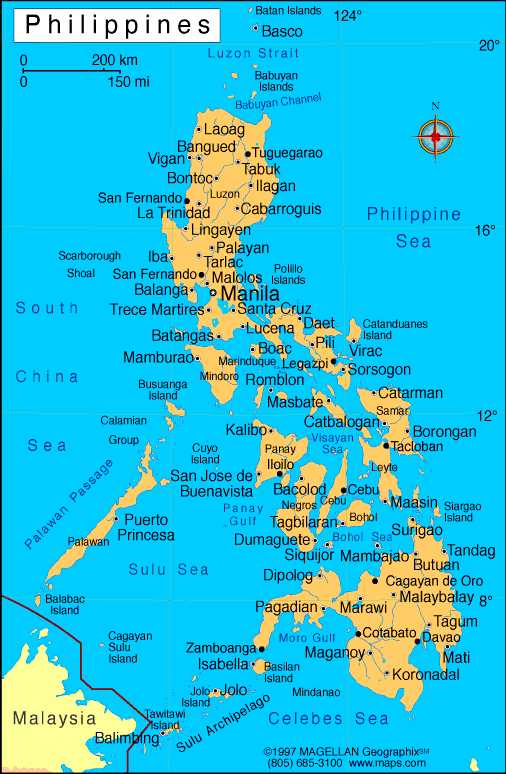Philippines Map: Regions, Geography, Facts & Figures
The Philippines is an archipelagic country in Southeast Asia situated in the western Pacific Ocean. The country is comprised of 7,107 islands divided into three main island groups: Luzon, Visayas, and Mindanao. The capital city is Manila and Quezon City is the most populous city in the country. The Philippines is located near Taiwan to the north, Vietnam and Malaysia to the west, and Indonesia to the south. And as the Philippines map shows, its location makes it vulnerable to typhoons and earthquakes. Overall, the Philippine Islands are eminent for their rich history and diverse culture, enriched by multicultural influences originating from the Malay, Spanish, Chinese, and American cultures.
If you want to discover more in-depth information on the Philippines as a country, check out our Philippines Profile!
Plus, test your country knowledge with our cultural quiz, Asian Mythological Creatures.

Philippines Facts: History
The Philippines has a rich and fascinating history that has been shaped by various colonizers throughout the years, including Spain, Japan, and the United States. During the Spanish colonial period, which lasted over 300 years, the country was introduced to Christianity and Western education. The United States then took control and established a democratic government that lasted for decades. The Japanese occupation during World War II brought about great suffering for the Filipino people, but it also led to the country's eventual independence.
In 1946, the Philippine Islands officially became known as the Republic of the Philippines, a name that symbolized its newfound freedom and sovereignty. Today, the country remains a melting pot of cultures, with influences from its diverse indigenous groups, as well as its colonizers and neighbors in Southeast Asia. Its rich history and vibrant culture continue to attract visitors from all over the world.
Philippines Facts: Geography
The Philippines is located in the western Pacific Ocean and is part of Southeast Asia. It has a total land area of 300,000 square kilometers and is divided into 18 regions. The country is known for its beautiful beaches, islands, and mountain ranges. The highest peak in the country is Mount Apo located in Mindanao. The country is surrounded by the South China Sea to the west, the Philippine Sea to the east, and the Celebes Sea to the south.
The map of the Philippines is divided into three main island groups: Luzon, Visayas, and Mindanao. Some smaller islands include Mindoro, Panay, Samar, and Leyte. Some of the major cities in the Philippines include Cebu, Davao, Zamboanga, and Cagayan. Like some other countries on the map of Asia, such as Thailand, the Philippines is prone to typhoons due to its location in the western Pacific Ocean. The typhoon season usually starts in June and ends in November.
Philippines Facts: Tourist Attractions
The Philippines is a popular tourist destination because of its natural wonders, breathtaking beaches, and incredible culture. Some of the best tourist attractions on the Philippines atlas are:
- Palawan: Known for its clear waters, limestone cliffs, and beautiful beaches, Palawan is home to the Puerto Princesa Underground River, one of the New Seven Wonders of Nature.
- Bohol: This area is famous for its Chocolate Hills, a geological formation of over 1,200 hills that turn brown during the dry season. The island is also known for its tarsiers, one of the world's smallest primates.
- Island Paradises: Samar and Leyte are known for their stunning beaches and natural wonders. The Sohoton Caves and Natural Bridge in Samar are popular tourist attractions.
- Cebu: Cebu is one of the most developed provinces in the Philippines and is known for its beaches, diving spots, and historical landmarks such as Magellan's Cross.
- Sulu: Famed for its beautiful beaches and cultural heritage, Bud Daho Mountain is a popular hiking spot on Sulu.

People Also Search For...
If you're inspecting the the Philippines country map, you may have some queries about the region. Here are some of the most frequently asked questions, along with their answers.
What Is the Old Name of Philippines?
The Philippines was previously known as "Las Islas Filipinas," named after King Philip II of Spain. The country gained its independence from Spain in 1898, and the name was officially changed to "Philippines" after the American colonization. This change was made in honor of King Philip II.
Does Philippines Have 7,641 Islands?
The Philippines is a beautiful archipelago located in Southeast Asia, consisting of a staggering 7,641 islands. With its pristine beaches, crystal-clear waters, lush forests, and diverse marine life, the country is a paradise for nature lovers and adventure seekers alike.
What Is the Philippines Known For?
The Philippines is known for its breathtaking beaches, rich culture, diverse cuisine, and friendly people. It is also famous for its iconic landmarks such as the Chocolate Hills, Mayon Volcano, and Boracay Island.
What Country Do the Philippines Belong To?
The Philippines is an independent country and does not belong to any other nation. It was a part of the Spanish Empire from 1521 to 1898 before gaining independence in 1946. It is an archipelagic country located in Southeast Asia, bordered by the Philippine Sea, the South China Sea, and the Celebes Sea.








